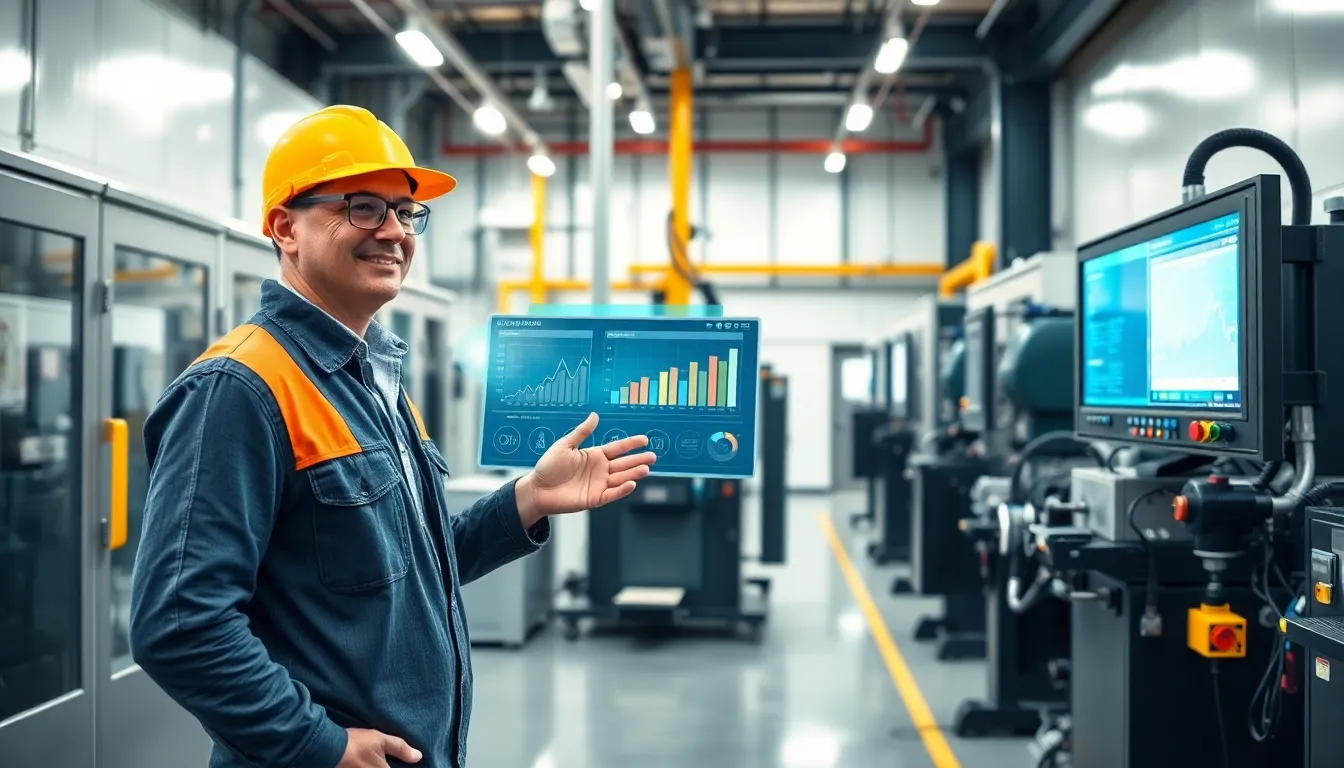Picture this: a factory where machines chat with each other like old friends at a coffee shop. Welcome to the world of Internet of Things (IoT) industrial automation, where connectivity meets efficiency in a way that would make even the most skeptical techie raise an eyebrow. It’s not just about robots doing the heavy lifting anymore; it’s about creating a symphony of smart devices that work seamlessly together.
In this brave new world, businesses are transforming operations, slashing costs, and boosting productivity like never before. Who wouldn’t want to trade in their old, clunky processes for a sleek, automated system that practically runs itself? As IoT continues to evolve, it’s time to dive into the nuts and bolts of how this technology is revolutionizing industries and why it’s essential for companies to hop on the bandwagon before they get left in the dust.
Table of Contents
ToggleOverview of Internet of Things Industrial Automation
Internet of Things (IoT) industrial automation connects machines, devices, and systems to streamline operations. This technology enables real-time data collection, analysis, and communication within a manufacturing environment. Smart sensors play a critical role by monitoring equipment performance and detecting anomalies, leading to predictive maintenance.
Implementing IoT in industrial settings enhances efficiency. For instance, automated workflows optimized by data insights reduce production downtime significantly. Additionally, companies achieve greater accuracy in resource management through intelligent systems that adjust operations based on live data.
Integrating IoT solutions improves collaboration among devices. Various machines can share information seamlessly, facilitating coordinated actions that contribute to smooth operations. For example, robotic arms and conveyor systems work together more effectively, reducing delays and errors.
Adopting IoT technology often results in significant cost savings. Organizations can minimize energy consumption through real-time monitoring and control of machinery. This proactive approach not only lowers operational costs but also contributes to sustainable practices.
Data-driven decision-making becomes a reality with IoT industrial automation. Businesses leverage analytics to improve production processes and product quality. Furthermore, insights gained from connected devices inform strategic investments in technology upgrades and workforce training.
Managing IoT security is essential. Vulnerabilities in connected devices can pose risks to operational integrity. Companies must prioritize cybersecurity measures to protect sensitive information and ensure the reliability of their automated systems.
Key Components of IoT in Industrial Automation

Key components driving IoT in industrial automation include sensors, devices, and connectivity solutions. Each plays a vital role in enhancing operational efficiency and data-driven decision-making.
Sensors and Devices
Sensors gather real-time data from machines and environments. These smart devices monitor key parameters like temperature, pressure, and humidity. Advanced sensors enable predictive maintenance by analyzing equipment performance trends. Companies that implement these technologies can prevent costly downtimes. Devices like actuators and controllers execute commands based on sensor inputs, facilitating automated processes. Integration of various sensors improves overall efficiency and enhances the reliability of operations.
Connectivity Solutions
Connectivity solutions form the backbone of IoT systems. Wireless technologies like Wi-Fi, Bluetooth, and LoRaWAN allow seamless data exchange between devices. These solutions ensure that real-time information flows smoothly between machines and central systems. Cloud platforms provide the necessary infrastructure for data storage and analytics processing. Prioritizing robust connectivity improves collaboration and enhances the decision-making process. Companies benefit from a unified network that connects devices across production lines, leading to optimized workflows and increased productivity.
Benefits of Implementing IoT in Industry
Implementing IoT in industry brings numerous advantages that can significantly transform operations. Smart solutions enhance productivity and operational efficiency, positioning businesses to thrive in competitive markets.
Enhanced Efficiency
Enhanced efficiency stands out as a primary benefit of IoT integration. Automation processes streamline production, resulting in faster output without sacrificing quality. Devices communicate in real-time, allowing adjustments based on performance metrics. Organizations utilize smart sensors to monitor equipment health continuously, enabling predictive maintenance. These proactive measures reduce unplanned downtimes, which can cause financial losses. By optimizing workflows, IoT reduces manual interventions, freeing employees to focus on higher-value tasks. Consequently, companies experience improved resource management and reduced operational costs. The ability to adjust systems dynamically ensures sustained performance at optimal levels.
Real-Time Data Analytics
Real-time data analytics represent a critical component of IoT benefits. Companies gather precise data on manufacturing processes, which informs strategic decisions. By analyzing information as it occurs, organizations can identify trends and address issues swiftly. Advanced analytics tools interpret this data, providing invaluable insights for enhancing production efficiency. Continuous monitoring of key performance indicators empowers businesses to refine processes and predict future demands. Moreover, IoT systems enable data-driven decision-making, allowing companies to respond promptly to market changes. This adaptability enhances operational agility, positioning firms for sustained growth and innovation in dynamic environments.
Challenges in IoT Industrial Automation
IoT industrial automation brings numerous challenges that can impede its effective implementation. Addressing these obstacles is crucial for maximizing the benefits of this technology.
Security Concerns
Security concerns pose significant risks in IoT industrial automation. Vulnerable connected devices can become entry points for cyberattacks, potentially compromising sensitive data. Protecting systems against these threats requires robust cybersecurity strategies. Companies must implement encryption protocols, regular updates, and intrusion detection systems. Such measures reduce the risk of breaches while maintaining operational integrity. Failing to prioritize security can lead to significant financial losses and reputational damage.
Integration with Legacy Systems
Integration with legacy systems presents another challenge in adopting IoT industrial automation. Older equipment often lacks compatibility with modern technologies, complicating the implementation process. Companies may face difficulties in data sharing and system interoperability. Upgrading legacy systems to support IoT can incur substantial costs and require extensive downtime. Transitioning smoothly involves careful planning and phased rollouts to minimize disruption. Focusing on seamless integration can enhance overall productivity and enable companies to leverage the full potential of IoT solutions.
Future Trends in IoT Industrial Automation
Emerging trends in IoT industrial automation signal a shift toward even greater efficiency and innovation. Advanced analytics play a crucial role, allowing companies to derive actionable insights from vast amounts of data collected by sensors. Autonomous systems are expected to take center stage, streamlining operations through AI and machine learning integration.
Increased focus on edge computing enhances data processing speed while reducing latency. As devices process data closer to the source, networks become more efficient, resulting in faster decision-making. Additionally, 5G technology is set to revolutionize IoT connectivity, enabling real-time communication among devices with minimal delay.
Another important trend involves the rise of digital twins, which create virtual replicas of physical assets. These replicas allow for remote monitoring and simulation, enabling better decision-making and resource allocation. Predictive maintenance continues to gain traction, helping organizations anticipate equipment failure and reduce downtime significantly.
Sustainability becomes a paramount concern for industries adopting IoT technologies. Companies prioritize energy-efficient solutions to minimize their environmental footprints while optimizing resource utilization. The integration of renewable energy sources into IoT systems supports sustainability goals and enhances operational efficiency.
Cybersecurity strategies must evolve in response to growing threats, as connected devices become more prevalent. Organizations are implementing multi-layered security frameworks, ensuring robust protection against potential vulnerabilities. Compliance with regulations also shapes the future, driving the adoption of standards aimed at securing data and maintaining system integrity.
Continuous innovation, collaboration, and adaptability define the future of IoT industrial automation. Companies leading these trends will secure a competitive advantage by embracing transformative technologies and prioritizing effective resource management.
Embracing IoT industrial automation is crucial for businesses aiming to thrive in today’s fast-paced environment. The interconnectedness of devices not only streamlines operations but also fosters a culture of continuous improvement and innovation. By leveraging real-time data and advanced analytics, companies can enhance efficiency and make informed decisions that drive growth.
However, navigating the challenges of security and legacy system integration requires careful planning and strategic implementation. As technology evolves, staying ahead of trends like AI, edge computing, and 5G will be essential. Organizations that prioritize these advancements will position themselves as leaders in their industries, ready to tackle the future with confidence.





